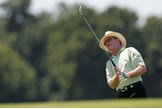Words From The Wise: Tom Kite
Published: Last updated:
The 62-year-old Texan represented his country in seven Ryder Cups, and served as captain in 1997.
Over the course of a distinguished career in golf, Tom Kite has achieved great things. US Open champion at a blustery Pebble Beach in 1992, the now 62-year old Texan was the leading money-winner on the PGA Tour in 1981 and represented his country in seven Ryder Cups, as well as serving as non-playing captain in 1997. Along the way, he has always had things to say about the game that has been his life. Here are just a few of his thoughts on the current state of the game.
For me, golf has never changed. The quest to get better is still there. I may play a little less these days, but I still love
competing. Even the golf I play at home is mostly in preparation for a tournament. So it’s social golf, but it’s not. I play with a bunch of good players I’ve known since I was a teenager. We have great matches, but when I quit travelling I’m not sure how much of that I’m going to do.
I really think luck, good and bad, should be a huge part of the game. Golf was never meant to be fair. And it isn’t in the UK. But on the PGA Tour everything is often too perfect. The young guys seem to want and enjoy that. But it’s too black and white for me. Golf should be a thousand shades of grey. And links golf is like that.
When I was appointed Ryder Cup captain, I went back and studied the history of the matches. At the time (up to 1997), the statistics painted a clear picture that if you played less than twice before the singles you were almost certain to lose on Sunday. And the same was true if you played all four matches before the singles. The percentages were amazing, somewhere in the low 90s.
As history tends to repeat itself in golf, I was determined to play everyone in my team at least twice over the first two days. Equally, I was keen that no one should play all four before the singles. I managed the first part okay, but didn’t quite make it on the second. Tiger ended up playing four and of course he lost on the Sunday, which only supported my original theory. I’m not sure what the numbers are now, but I’d be surprised if they have changed much.
Belly putters and long putters are legal and both are wonderful ways to putt. But I don’t think they are good for golf. Then it comes to equipment, the USGA and the R&A have been very neglectful. It all goes back to the Ping case in the early 1980s. When the authorities tried to make a rule about the shape and width of grooves on irons they found themselves being sued. They backed down back then and haven’t stood up to anything else since.
The Ping case was so detrimental to the game. What Karsten Solheim did was fine for him and his company, but it wasn’t in the best interests of golf. If the USGA had won that case, golf would be a lot different – and a lot better – than it is now. If I were in charge of golf equipment I’d roll things back, starting with the ball. I’m not an engineer, but it needs to be rolled back to where the longer hitters don’t gain the most. We need to create a situation where Dustin Johnson and Aunt Agnes both gain, say, 10 per cent on a big hit.
If you have a course that is 7,600-yards long you have to maintain all of it. You have to water it more. You have to mow it more. You have to fertilize it more. All of which costs more. Then you want it to be more difficult. So you need more bunkers and new tees. It never ends and the costs are always increasing. So many things need to be rolled back if only for the sustainability of the game.
In the 1980s and 1990s, the European Ryder Cup captains pursued a policy of sitting guys out a lot of times. But you can’t hide people on Sunday, which is the day when almost half of the matches are played. So it is all-important. You have to have your guys firing on the Sunday. My philosophy on better-ball (fourball) was that I could pair almost anyone with anyone. But on alternate-shot (foursomes), I needed ‘like with like.’ So I went down the list of players and figured out where each guy was best suited. Some I could play anywhere. But others were obviously more suited to one format or another. Steady players – Jeff Maggert for example – are best in alternateshot. Tom Lehman I thought I could play anywhere. And Davis Love, a guy who made a lot of birdies, would be best in betterball. That’s how I matched up my guys. And it worked out pretty well, even if we lost by one point in the end.
I’ve finished second in a tournament this year. I’ve had other top-10s. I’ve led two events going into the final round. So I can still play. But when I look at Hale Irwin and Tom Watson I get real motivation. They are great role models. I want to be doing as well as they do. And when I see them play well, I know that I can play well too.
Golf has never been work to me. To be honest, I’ve never worked a day in my life. All I’ve ever done is have fun. I’m just a 62-year-old kid who wants to play nine more holes before it gets dark.

